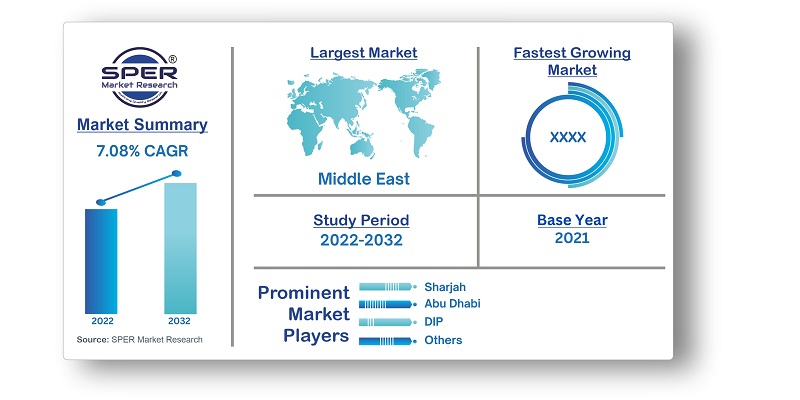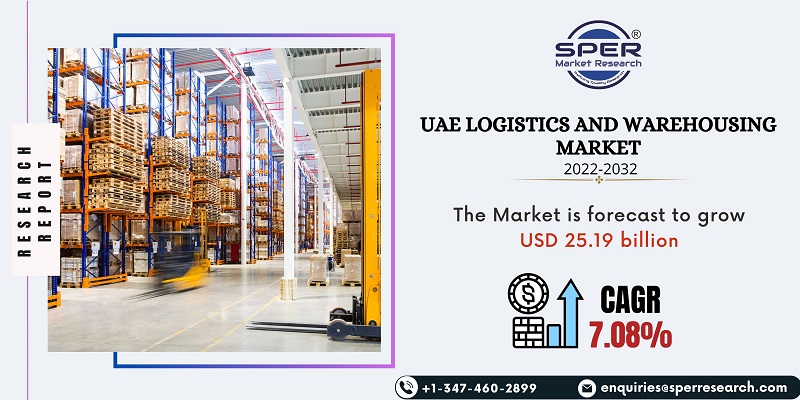
UAE Logistics and Warehousing Market Size, Growth Drivers & Business Opportunities 2032
UAE Logistics and Warehousing Market Size- By Freight Forwarding, By Warehousing, By Courier, Express and Parcel Logistics, By 3PL Logistics - Regional Outlook, Competitive Strategies and Segment Forecast to 2032
| Published: Jan-2023 | Report ID: AMIN2302 | Pages: 1 - 103 | Formats*: |
| Category : Automotive & Transportation | |||
- The favorable location of the UAE on a transcontinental trade route and its superior multi-modal connectivity contribute to the country's robust freight forwarding industry.
- Sustained growth is expected in the logistics and warehousing industry in the UAE, driven by factors such as the country's strategic location, ongoing rail construction, continuous infrastructural development, increasing foreign investments, and the rapid growth of e-commerce.


| Report Metric | Details |
| Market size available for years | 2019-2032 |
| Base year considered | 2021 |
| Forecast period | 2022-2032 |
| Segments covered | By Freight Forwarding, By Warehousing, By Courier, Express and Parcel Logistics, By 3PL Logistics |
| Regions covered | Abu Dhabi, DAFZA, DIC, DIP, JAFZA, KIZAD, Sharjah |
| Companies Covered | Agility, Al Futtaim, Aramex, Century Express,DB Schenker, DHL, DSV-Panalpina, DTDC, Emirates Logistics, Emirates Post, Fedex, GAC, Global Shipping Line, Gulf Wide Express, Hellman, Kuehne Nagel, Max Courier Services, Skycom Express, Skyexpress, Skynet, TCS Express, Yussen Logistics |
- 3PL Companies
- Consultancy Companies
- E Commerce Logistics Companies
- Express Delivery Logistics Companies
- Freight Forwarding Companies
- Logistics/Warehousing Companies
- Real Estate Companies/ Industrial Developers
- Others
| By Freight Forwarding: |
|
| By Warehousing: |
|
| By Courier: |
|
- UAE Logistics and Warehousing Market Size (FY'2022-FY'2032)
- Overview of UAE Logistics and Warehousing Market
- Segmentation of UAE Logistics and Warehousing Market By Freight Forwarding (Mode of Freight, Type of Freight, Contract and Integrated Logistics, End User, Flow Corridors)
- Segmentation of UAE Logistics and Warehousing Market By Warehousing (Business Model, , Contract and Integrated Warehouses, End User, Type of Warehouses)
- Segmentation of UAE Logistics and Warehousing Market By Courier, Express and Parcel Logistics (Air and Ground Shipments, Delivery Period, International and Domestic Shipments, Market Structure)
- Segmentation of UAE Logistics and Warehousing Market By 3PL Logistics
- Statistical Snap of UAE Logistics and Warehousing Market
- Expansion Analysis of UAE Logistics and Warehousing Market
- Problems and Obstacles in UAE Logistics and Warehousing Market
- Competitive Landscape in the UAE Logistics and Warehousing Market
- Impact of COVID-19 and Demonetization on UAE Logistics and Warehousing Market
- Details on Current Investment in UAE Logistics and Warehousing Market
- Competitive Analysis of UAE Logistics and Warehousing Market
- Prominent Market Players in the UAE Logistics and Warehousing Market
- SWOT Analysis of UAE Logistics and Warehousing Market
- UAE Logistics and Warehousing Market Future Outlook and Projections (FY'2022-FY'2032)
- Recommendations from Analyst
1.1. Scope of the report1.2. Market segment analysis
2.1 Research data source
2.1.1 Secondary data2.1.2 Primary data2.1.3 SPER’s internal database2.1.4 Premium insight from KOL’s
2.2 Market size estimation
2.2.1 Top-down and Bottom-up approach
2.3 Data triangulation
4.1. Driver, Restraint, Opportunity and Challenges analysis
4.1.1 Drivers4.1.2 Restraints4.1.3 Opportunities4.1.4 Challenges
4.2. COVID-19 Impacts of the UAE Logistics and Warehousing Market
5.1. SWOT analysis
5.1.1 Strengths5.1.2 Weaknesses5.1.3 Opportunities5.1.4 Threats
5.2. PESTEL analysis
5.2.1 Political landscape5.2.2 Economic landscape5.2.3 Social landscape5.2.4 Technological landscape5.2.5 Environmental landscape5.2.6 Legal landscape
5.3. PORTER’S five forces analysis
5.3.1 Bargaining power of suppliers5.3.2 Bargaining power of Buyers5.3.3 Threat of Substitute5.3.4 Threat of new entrant5.3.5 Competitive rivalry
5.4. Heat map analysis
6.1 UAE Logistics and Warehousing Car Manufacturing Base Distribution, Sales Area, Product Type6.2 Mergers & Acquisitions, Partnerships, Product Launch, and Collaboration in UAE Logistics and Warehousing Market
7.1 Mode of Freight
7.1.1 Air Freight7.1.2 Road Freight7.1.3 Sea Freight
7.2 Type of Freight
7.2.1 Domestic Freight Revenue7.2.2 International Freight
7.3 Contract and Integrated
7.3.1 Contract Logistics7.3.2 Integrated Logistics
7.4 End User
7.4.1 Automotive7.4.2 Food and Beverages7.4.3 Manufacturing7.4.4 Oil and Gas
7.4.5 Retail7.4.6 Others include Healthcare, Telecommunication and many more
7.5 Flow Corridors
7.5.1 African Countries7.5.2 America7.5.3 Asian Countries7.5.4 European Countries7.5.5 Middle East
8.1 Business Model
8.1.1 Agriculture8.1.2 CFS/ICD8.1.3 Cold Storage8.1.4 Industrial/Retail
8.2 Contract and Integrated Warehouses
8.2.1 Contract Warehouses8.2.2 Integrated Warehouses
8.3 End User
8.3.1 Automotive8.3.2 Food and Beverages8.3.3 Health Care8.3.4 Manufacturing8.3.5 Oil and Gas8.3.6 Retail
8.4 Type of Warehouses
8.4.1 Closed Warehouses8.4.2 Open Warehouses
8.5 Region
8.5.1 DAFZA8.5.2 DIC8.5.3 DIP8.5.4 JAFZA8.5.5 Others include KIZAD, Sharjah, Abu Dhabi and many more
9.1 By Air and Ground9.1.1 Air Shipments9.1.2 Ground Shipments9.2 By Delivery Period9.2.1 Next Day Delivery9.2.2 Same Day Delivery9.2.3 Two or More Days Delivery9.3 By International and Domestic9.3.1 Domestic Shipments9.3.2 International Shipments9.4 By Market Structure9.4.1 B2B9.4.2 B2C9.4.3 C2C
10.1 Market Type
11.1 UAE Logistics and WarehousingSize and Market Share by Region (2019-2025)11.2 UAE Logistics and WarehousingSize and Market Share by Region (2026-2032)11.3 Abu Dhabi11.4 DAFZA11.5 DIC11.6 DIP11.7 JAFZA11.8 KIZAD
11.9 Sharjah
12.1 Agility
12.1.1 Company details12.1.2 Financial outlook12.1.3 Product summary12.1.4 Recent developments
12.2 Al Futtaim
12.2.1 Company details12.2.2 Financial outlook12.2.3 Product summary12.2.4 Recent developments
12.3 Aramex
12.3.1 Company details12.3.2 Financial outlook12.3.3 Product summary12.3.4 Recent developments
12.4 Century Express
12.4.1 Company details12.4.2 Financial outlook12.4.3 Product summary12.4.4 Recent developments
12.5 DB Schenker
12.5.1 Company details12.5.2 Financial outlook12.5.3 Product summary12.5.4 Recent developments
12.6 DHL
12.6.1 Company details12.6.2 Financial outlook12.6.3 Product summary12.6.4 Recent developments
12.7 DSV-Panalpina
12.7.1 Company details12.7.2 Financial outlook12.7.3 Product summary12.7.4 Recent developments
12.8 DTDC
12.8.1 Company details12.8.2 Financial outlook12.8.3 Product summary12.8.4 Recent developments
12.9 Emirates Logistics
12.9.1 Company details12.9.2 Financial outlook12.9.3 Product summary12.9.4 Recent developments
12.10 Emirates Post
12.10.1 Company details12.10.2 Financial outlook12.10.3 Product summary12.10.4 Recent developments
12.11 Fedex
12.11.1 Company details12.11.2 Financial outlook12.11.3 Product summary12.11.4 Recent developments
12.12 GAC
12.12.1 Company details12.12.2 Financial outlook12.12.3 Product summary12.12.4 Recent developments
12.13 Global Shipping Line
12.13.1 Company details12.13.2 Financial outlook12.13.3 Product summary12.13.4 Recent developments
12.14 Gulf Wide Express
12.14.1 Company details12.14.2 Financial outlook12.14.3 Product summary12.14.4 Recent developments
12.15 Hellman
12.15.1 Company details12.15.2 Financial outlook12.15.3 Product summary12.15.4 Recent developments
12.16 Kuehne Nagel
12.16.1 Company details12.16.2 Financial outlook12.16.3 Product summary12.16.4 Recent developments
12.17 Max Courier Services
12.17.1 Company details12.17.2 Financial outlook12.17.3 Product summary12.17.4 Recent developments
12.18 Skycom Express
12.18.1 Company details12.18.2 Financial outlook12.18.3 Product summary12.18.4 Recent developments
12.19 Skyexpress
12.19.1 Company details12.19.2 Financial outlook12.19.3 Product summary12.19.4 Recent developments
12.20 Skynet
12.20.1 Company details12.20.2 Financial outlook12.20.3 Product summary12.20.4 Recent developments
12.21 TCS Express
12.21.1 Company details12.21.2 Financial outlook12.21.3 Product summary12.21.4 Recent developments
12.22 Yussen Logistics
12.22.1 Company details12.22.2 Financial outlook12.22.3 Product summary12.22.4 Recent developments
SPER Market Research’s methodology uses great emphasis on primary research to ensure that the market intelligence insights are up to date, reliable and accurate. Primary interviews are done with players involved in each phase of a supply chain to analyze the market forecasting. The secondary research method is used to help you fully understand how the future markets and the spending patterns look likes.
The report is based on in-depth qualitative and quantitative analysis of the Product Market. The quantitative analysis involves the application of various projection and sampling techniques. The qualitative analysis involves primary interviews, surveys, and vendor briefings. The data gathered as a result of these processes are validated through experts opinion. Our research methodology entails an ideal mixture of primary and secondary initiatives.



Frequently Asked Questions About This Report
PLACE AN ORDER
Year End Discount
Sample Report
Pre-Purchase Inquiry
NEED CUSTOMIZATION?
Request CustomizationCALL OR EMAIL US
100% Secure Payment






Related Reports
Our Global Clients
Our data-driven insights have influenced the strategy of 200+ reputed companies across the globe.




















